
|
You entered: ice
 Saturn with Moons Tethys and Dione
Saturn with Moons Tethys and Dione
31.05.1997
Saturn and two of its larger moons - Tethys and Dione - were photographed by the Voyager 1 spacecraft which flew by the planet in November of 1980. This picture gives an indication of Saturn's extensive ring system, which can be seen casting a shadow on the planet, as does Tethys.
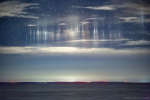 Light Pillars over Whitefish Bay
Light Pillars over Whitefish Bay
23.10.2018
What's happening in the sky? Unusual lights appeared last week to hover above Whitefish Bay on the eastern edge of Lake Superior between the USA and Canada. Unsure of the cause, the Michigan-based...
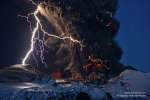 Ash and Lightning Above an Icelandic Volcano
Ash and Lightning Above an Icelandic Volcano
30.07.2012
Why did the picturesque 2010 volcanic eruption in Iceland create so much ash? Although the large ash plume was not unparalleled in its abundance, its location was particularly noticeable because it drifted across such well-populated areas.
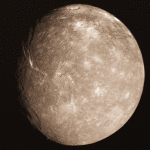 Uranus' Largest Moon: Titania
Uranus' Largest Moon: Titania
3.03.1996
Titania's tortured terrain is a mix of valleys and craters. NASA's interplanetary robot spacecraft Voyager 2 passed this moon of Uranus in 1986 and took the above photograph. The photograph was then transmitted back to earth by radio.
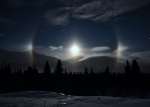 Alaskan Moondogs
Alaskan Moondogs
26.01.2013
Moonlight illuminates a snowy scene in this night land and skyscape made on January 17 from Lower Miller Creek, Alaska, USA. Overexposed near the mountainous western horizon is the first quarter Moon itself, surrounded by an icy halo and flanked left and right by moondogs.
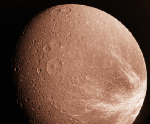 Saturn's Moon Dione
Saturn's Moon Dione
8.10.1995
Dione, one of Saturn's larger moons, is remarkable for its bright surface streaks. These streaks run across some of Dione's many craters, which indicate that the process which created the streaks occurred later than the process which created the craters.
 Good Morning Mars
Good Morning Mars
19.06.1998
Looking down on the Northern Hemisphere of Mars on June 1, the Mars Global Surveyor spacecraft's wide angle camera recorded this morning image of the red planet. Mars Global Surveyor's orbit...
 Invader From Earth
Invader From Earth
7.01.1999
These technicians are working on the solar-paneled Mars Polar Lander - yet another robotic spacecraft scheduled to invade the red planet. Mars Polar Lander is part of a series of missions focusing on a search for evidence of past or present life.
 Ash and Lightning Above an Icelandic Volcano
Ash and Lightning Above an Icelandic Volcano
19.04.2010
Why did the recent volcanic eruption in Iceland create so much ash? Although the large ash plume was not unparalleled in its abundance, its location was particularly noticeable because it drifted across such well populated areas.
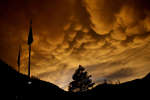 Mammatus Clouds Over Olympic Valley
Mammatus Clouds Over Olympic Valley
19.02.2011
What's happened to these clouds? Normal cloud bottoms are flat because moist warm air that rises and cools will condense into water droplets at a very specific temperature, which usually corresponds to a very specific height. After water droplets form that air becomes an opaque cloud.
|
January February March April May June July |
|||||||||||||||||||||||||||||||||||||||||||||||||